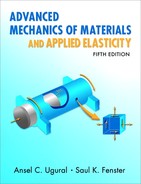Contents
1.5 Definition and Components of Stress
1.6 Internal Force-Resultant and Stress Relations
1.7 Stresses on Inclined Sections
1.8 Variation of Stress within a Body
1.9 Plane-Stress Transformation
1.10 Principal Stresses and Maximum In-Plane Shear Stress
1.11 Mohr’s Circle for Two-Dimensional Stress
1.12 Three-Dimensional Stress Transformation
1.13 Principal Stresses in Three Dimensions
1.14 Normal and Shear Stresses on an Oblique Plane
1.15 Mohr’s Circles in Three Dimensions
1.16 Boundary Conditions in Terms of Surface Forces
Chapter 2 Strain and Material Properties
2.4 Equations of Compatibility
2.5 State of Strain at a Point
2.8 Elastic versus Plastic Behavior
2.9 Hooke’s Law and Poisson’s Ratio
2.11 Hooke’s Law for Orthotropic Materials
2.12 Measurement of Strain: Strain Rosette
2.14 Strain Energy in Common Structural Members
2.15 Components of Strain Energy
Chapter 3 Problems in Elasticity
3.2 Fundamental Principles of Analysis
Part A—Formulation and Methods of Solution
3.5 Comparison of Two-Dimensional Isotropic Problems
3.7 Solution of Elasticity Problems
3.9 Basic Relations in Polar Coordinates
3.10 Stresses Due to Concentrated Loads
3.11 Stress Distribution Near Concentrated Load Acting on a Beam
3.12 Stress Concentration Factors
3.14 Spherical and Cylindrical Contacts
3.15 Contact Stress Distribution
4.5 Yield and Fracture Criteria
4.6 Maximum Shearing Stress Theory
4.7 Maximum Distortion Energy Theory
4.8 Octahedral Shearing Stress Theory
4.9 Comparison of the Yielding Theories
4.10 Maximum Principal Stress Theory
4.15 Failure Criteria for Metal Fatigue
4.17 Dynamic and Thermal Effects
5.2 Pure Bending of Beams of Symmetrical Cross Section
5.3 Pure Bending of Beams of Asymmetrical Cross Section
5.4 Bending of a Cantilever of Narrow Section
5.5 Bending of a Simply Supported Narrow Beam
5.6 Elementary Theory of Bending
5.8 Effect of Transverse Normal Stress
5.11 Statically Indeterminate Systems
5.12 Energy Method for Deflections
5.15 Comparison of the Results of Various Theories
5.16 Combined Tangential and Normal Stresses
Chapter 6 Torsion of Prismatic Bars
6.2 Elementary Theory of Torsion of Circular Bars
6.3 Stresses on Inclined Planes
6.4 General Solution of the Torsion Problem
6.6 Prandtl’s Membrane Analogy
6.7 Torsion of Narrow Rectangular Cross Section
6.8 Torsion of Multiply Connected Thin-Walled Sections
6.9 Fluid Flow Analogy and Stress Concentration
6.10 Torsion of Restrained Thin-Walled Members of Open Cross Section
6.11 Curved Circular Bars: Helical Springs
Part A—Finite Difference Method
7.3 Finite Difference Equations
7.8 Arbitrarily Oriented Bar Element
7.10 Force-Displacement Relations for a Truss
7.12 Properties of Two-Dimensional Elements
7.13 General Formulation of the Finite Element Method
7.14 Triangular Finite Element
7.15 Case Studies in Plane Stress
Chapter 8 Axisymmetrically Loaded Members
8.4 Application of Failure Theories
8.5 Compound Cylinders: Press or Shrink Fits
8.6 Rotating Disks of Constant Thickness
8.8 Rotating Disks of Variable Thickness
8.9 Rotating Disks of Uniform Stress
8.10 Thermal Stresses in Thin Disks
8.11 Thermal Stresses in Long Circular Cylinders
Chapter 9 Beams on Elastic Foundations
9.7 Beams Supported by Equally Spaced Elastic Elements
9.8 Simplified Solutions for Relatively Stiff Beams
9.9 Solution by Finite Differences
Chapter 10 Applications of Energy Methods
10.5 Unit- or Dummy-Load Method
10.7 Statically Indeterminate Systems
10.8 Principle of Virtual Work
10.9 Principle of Minimum Potential Energy
10.10 Deflections by Trigonometric Series
Chapter 11 Stability of Columns
11.3 Buckling of Pinned-End Columns
11.4 Deflection Response of Columns
11.5 Columns with Different End Conditions
11.6 Critical Stress: Classification of Columns
11.9 Eccentrically Loaded Columns: Secant Formula
11.10 Energy Methods Applied to Buckling
11.11 Solution by Finite Differences
11.12 Finite Difference Solution for Unevenly Spaced Nodes
Chapter 12 Plastic Behavior of Materials
12.3 Idealized Stress–Strain Diagrams
12.4 Instability in Simple Tension
12.5 Plastic Axial Deformation and Residual Stress
12.6 Plastic Defection of Beams
12.7 Analysis of Perfectly Plastic Beams
12.8 Collapse Load of Structures: Limit Design
12.9 Elastic–Plastic Torsion of Circular Shafts
12.10 Plastic Torsion: Membrane Analogy
12.11 Elastic–Plastic Stresses in Rotating Disks
12.12 Plastic Stress–Strain Relations
12.13 Plastic Stress–Strain Increment Relations
12.14 Stresses in Perfectly Plastic Thick-Walled Cylinders
13.3 Strain–Curvature Relations
13.4 Stress, Curvature, and Moment Relations
13.5 Governing Equations of Plate Deflection
13.7 Simply Supported Rectangular Plates
13.8 Axisymmetrically Loaded Circular Plates
13.9 Deflections of Rectangular Plates by the Strain-Energy Method
Part B—Membrane Stresses in Thin Shells
13.11 Theories and Behavior of Shells
13.13 Symmetrically Loaded Shells of Revolution
13.14 Some Common Cases of Shells of Revolution
13.15 Thermal Stresses in Compound Cylinders
13.16 Cylindrical Shells of General Shape
Appendix A Problem Formulation and Solution
Appendix B Solution of the Stress Cubic Equation
Appendix C Moments of Composite Areas
C.4 Principal Moments of Inertia
D.1 Average Properties of Common Engineering Materials
D.2 Conversion Factors: SI Units to U.S. Customary Units
D.4 Deflections and Slopes of Beams
D.5 Reactions Deflections of Statically Indeterminate Beams
D.6 Stress Concentration Factors for Bars and Shafts with Fillets, Grooves, and Holes
